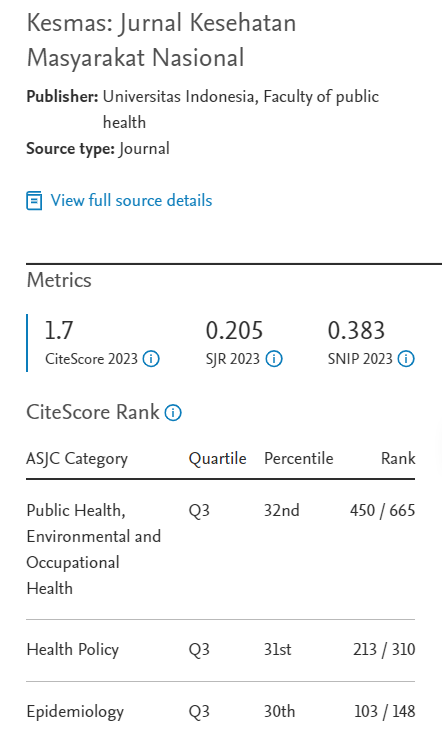Abstract
Hipertensi merupakan salah satu penyakit yang paling banyak terjadi di Jakarta. Ciri kepribadian tipe A, yaitu tampak selalu sibuk, terburu-buru, tidak sabar atau mudah marah, tampak pada beberapa pasien hipertensi. Penelitian potong lintang ini bertujuan untuk mengetahui hubungan antara kepribadian tipe A dengan hipertensi. Sebanyak 64 responden, yang usia > 30 tahun dan tidak sedang dalam pengobatan dengan antihipertensi, dipilih secara konsekutif di antara pengunjung Puskesmas Kelurahan Joglo-II antara 30 April – 5 Mei 2012. Tekanan darah diukur sesuai dengan protokol standar. Informasi tentang kepribadian dan faktor-faktor risiko yang lain dikumpulkan dengan wawancara menggunakan kuesioner. Analisis statistik menggunakan prosedur generalized linear model. Ditetapkan batas kemaknaan 0,05. Dari 64 responden, 36 orang (56,3%) mempunyai kepribadian tipe A dan 22 orang (34,4%) menderita hipertensi. Hipertensi didapatkan pada 13 dari 36 responden (36,1%) dengan kepribadian tipe A dan 9 dari 28 responden (32,1%) tanpa kepribadian tersebut. Pada usia dan jenis kelamin yang disetarakan, risiko hipertensi lebih besar secara bermakna 1,3 kali pada responden dengan kepribadian tipe A dibandingkan dengan mereka dengan kepribadian tipe non-A (PR = 1,3; nilai p = 0,003). Penambahan faktor-faktor risiko hipertensi yang lain melemahkan asosiasi, tetapi tidak mengubah kemaknaan statistik (PR = 1,2; nilai p = 0,04). Identifikasi tipe kepribadian disarankan sebagai bagian dari pencegahan hipertensi. Hypertension is one of the major diseases in Jakarta. The typical characteristics of type A personality include being busy, in hurry, impatient and irritable, were shown in some hypertensive patients. This cross-sectional study examined the relationhip between type A personality and hypertension. Sixty-four respondents (age > 30 years and were not on antihypertensive medication), were consecutively selected among patients attending Joglo-II Primary Health Center, between April 30 – May 5, 2012. Blood pressures were measured according to the standard protocol. Information on personality and other risk factors of hypertension were colected using interview- based questionnaires. Analyses were done using the general linear model at the significant level of 5%. Of 64 respondents, 36 respondents (56.3%) had type A personality and 22 respondents (34.4%) had hypertension. Hypertension were diagnosed in 13 (36.1%) out of 36 respondents with type-A personality and 9 (32.1%) out of 28 respondents with non-A type personality. Adjusted for age and sex, the risk of hypertension was 1.3 significantly higher in respondents who were type A personality than in those who were not (PR = 1,3; p value = 0.003). Further adjustment for other risk factors for hypertension attenuated the association, but remained significant (PR = 1,2; p vallue = 0,04). Identification of personality type is advisable as part of the efforts for preventing hypertension.
References
1. Setiawan Z. Prevalensi dan determinan hipertensi di Pulau Jawa. Kesmas Jurnal Kesehatan Masyarakat Nasional [online]. 2006 Oktober [diakses tangga 30 April 2012}; 1 (2): 57-62. Diunduh dalam: http://www.fkm.- ui.ac.id/index.php?option=com.content&task=view&id=56&Itemed- =70. 2. World Health Organization. Mean systolic blood pressure [cited 2012 April 30]. Available from: http://www.who.int/gho/ncd/risk_factors/- bloodpressuremeantext/en/index.html. 3. Tse H. Hypertension in Asia: what are the issues and opportunities to address the epidemic? [serial on internet]. Physician’s Academy for Cardiovascular Education (PACE); 2011 [cited 2012 Jun 25]. Available from: http://www.pace-cme.org/files/Download-slides-as-PDF-3-14- 2012_20-23-22.pdf. 4. Kementerian Kesehatan Republik Indonesia. Hindari hipertensi, konsumsi garam 1 sendok teh per hari [diakses tanggal 21 Agustus 2012]. Diunduh dalam: http://depkes. go.id/index.php/berita/press-release/ 263-hindari-hipertensi-konsumsi-garam-1-sendok-teh - perhari. html. 5. Hamid. Seminar the 5th scientific meeting on hypertension 2011. In: Dhuha S, ed. Astaga, prevalensi hipertensi di Indonesia sangat tinggi. 2011 [Diakses tanggal 3 Mei 2012]. Available from: http://www.today. co.id/read/2011/02/26/13140/astagaprevalensi_hipertensi _di_indonesia_sangat_tinggi. 6. Puskesmas Kelurahan Joglo II. Laporan tahunan tahun 2011. Jakarta: Puskesmas Kelurahan Joglo II; 2012. 7. Schroeder KE, Narkiewicz K, Kato M, Pesek C, Phillips B, Davison D, et al. Personality type and neural circulatory control. Hypertension [serial on internet]. 2000 Nov [cited 2012 May 3]; 36 (5): 830-3. Available from: http://hyper. ahajournals.org/content/36/5/830.full. 8. Al-Asadi JN. Type A behaviour pattern: is it a risk factor for hypertension? Eastern Mediterranean Health Journal [serial on internet]. 2010 [cited 2012 September 18]; 16(7): 740-5. Available from: http://applications. emro.who.int/emhj/V16/07/16_7_2010_0740_ 0745.pdf 9. Irvine J, Garner DM, Craig HM, Logan AG. Prevalence of type A behavior in untreated hypertensive individuals. Hypertension [serial on internet]. 1991 [cited 2012 September 19]; 18 (1): 72-8. Available from: http://hyper.ahajournals.org/content/18/1/72. 10. Newlin DB, Levenson RW. Cardiovascular responses of individual with Type A Behavior and parental coronary heart disease. Journal of Psychosomatic Research [serial on internet]. 1982 [cited 2012 September 7]; 26 (4): 393-402. Available from: http://istsocrates. berkeley.edu/~ucbpl/docs/18-Cardiovascular% 20Responses82.pdf 11. Friedman M, Byers SO, Diamant J, Rosenman RH. Plasma catecholamine response of coronary-prone subjects (type A) to a specific challenge. Metabolism [serial on internet]. 1975 Feb [cited 2012 September 20]; 24 (2): 205–10. Available from: http://www. sciencedirect. com /science/article/pii/0026049575900220 12. Kahn JP, Kornfeld DS, Frank KA, Heller SS, Hoar PF. Type A behavior and blood pressure during coronary artery bypass surgery. Psychological Medicine [serial on internet]. 1980 Jul [cited 2012 May 2]; 42 (4): 407- 14. Available from: http://www.psychosomaticmedicine. org/content/ 42/4/407.full.pdf 13. Lee DJ, Gomez-Marin O, Prineas RJ. Type A Behavior pattern and change in blood pressure from childhood to adolescence. American Journal of Epidemiology [serial on internet]. 1996 Jan [cited 2012 September 19]; 143 (1): 63-72. Available from: http://aje.oxfordjournals. org/content/143/1/63.full.pdf 14. Kotchen TA. Hypertensive vascular disease. In: Fauci AS, Kasper DL, Longo DL, Braunwald E, Hauser SL, James JL, et al., editors. Harrison’s principles of internal medicine. 17th ed. New York: McGraw Hill, 2008: p. 1549-54. 15. Dubey RK, Oprail S, Imthrun B, Jackson KE. Sex hormones and hypertension. Cardiovascular Research [serial on internet}. 2002 [cited 2012 May 8]; 53 (3): 688-708. Available from: oxfordjournals.org/content/ 53/3/688.full.pdf. 16. Guyton AC, John EH. Buku ajar fisiologi kedokteran. Edisi ke-9. Jakarta: EGC; 1997. 17. Feist J, Feist GJ. Pendahuluan untuk teori kepribadian. Edisi ke-3. Yogyakarta: Pustaka Pelajar; 2008.
Recommended Citation
Chitrayana N , Feby B , Lauren Y ,
et al.
Kepribadian Tipe A dan Risiko Hipertensi pada Orang Dewasa.
Kesmas.
2014;
8(8):
380-385
DOI: 10.21109/kesmas.v8i8.408
Available at:
https://scholarhub.ui.ac.id/kesmas/vol8/iss8/7







